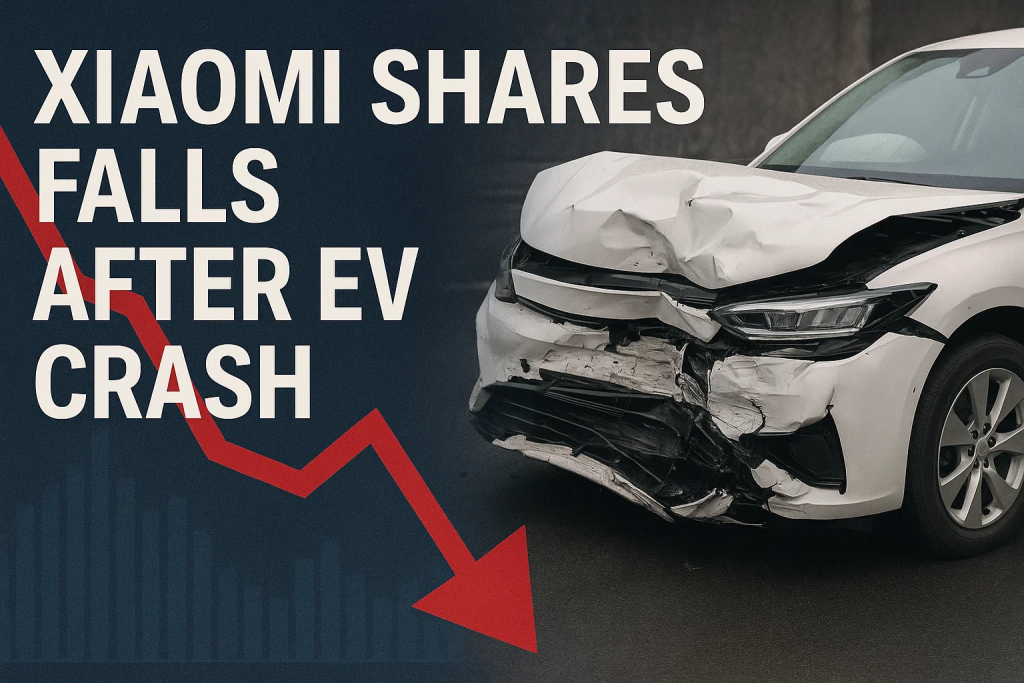The shocking news that Xiaomi Shares Falls After EV Crash sent ripples across both the stock market and the EV industry. The incident, involving a Xiaomi SU7 electric vehicle that caught fire and reportedly trapped a person inside, has raised pressing questions about safety, design, and investor trust.

Table of Contents
1. Crash Details & Incident Summary
| Parameter | Detail |
|---|---|
| Vehicle Model | Xiaomi SU7 Electric Sedan |
| Location & Time | Chengdu, Sichuan Province, China – Early Morning Hours |
| Sequence of Events | Vehicle collided with another car, crossed the median, and caught fire |
| Rescue Challenges | Doors failed to open, trapping the occupant inside |
| Casualties | One fatality confirmed; investigation ongoing |
The accident has intensified debates about EV safety systems, particularly regarding electric door handles and emergency release mechanisms that might fail under critical conditions.
2. Market Reaction: Xiaomi Shares Tumble
The incident immediately triggered a sharp decline in Xiaomi’s stock price, marking one of its biggest single-day drops in recent months.
| Indicator | Impact |
|---|---|
| Share Price Movement | Fell by nearly 8% intraday |
| Closing Value | Around 5–6% lower by market close |
| Market Sentiment | Negative, with high social media attention |
| Investor Confidence | Weakened due to repeated safety concerns |
This episode demonstrates how quickly investor confidence can erode when product safety incidents occur, particularly in industries built on consumer trust and advanced technology.
OnePlus partners with GodLike Esports
3. Design & Safety Concerns
One of the main reasons the Xiaomi Shares Falls After EV Crash story gained such traction was the safety question — specifically, why the car doors didn’t open after the collision.
Potential safety issues include:
- Electronic door handles: Many EVs feature flush or electronically operated door handles that fail during electrical malfunctions.
- Emergency overrides: A lack of clear mechanical backup may have contributed to the inability to open doors during the fire.
- Smart driving systems: Questions about Xiaomi’s assisted driving features and system responses during emergencies remain under review.
- Thermal risk: EV battery fires escalate rapidly, reducing rescue response time.
This tragic incident emphasizes the need for a balance between futuristic design and fundamental safety mechanisms.
4. Regulatory and Industry Reactions
After the Xiaomi Shares Falls After EV Crash event, regulators and industry players began re-evaluating electric vehicle safety standards.
- Government scrutiny: Authorities are increasing oversight on EV manufacturing, particularly focusing on door design, safety systems, and fire protection measures.
- Industry peers: Competing automakers may now prioritize manual overrides and fail-safe escape features in future models.
- Global attention: The case highlights a broader issue affecting the entire EV sector, not just Xiaomi — how safe are electric vehicles when systems fail?
This may lead to stricter certification requirements for all EVs sold in China and globally.
5. Xiaomi’s Response
Xiaomi moved quickly to address public concern following the incident. The company expressed condolences to the affected family and pledged to cooperate fully with the authorities investigating the crash.
| Focus Area | Xiaomi’s Action |
|---|---|
| Public Statement | Acknowledged the accident and ongoing investigation |
| Cooperation | Sharing vehicle data and technical information with investigators |
| Technical Measures | Reviewing door mechanisms and crash safety features |
| Brand Assurance | Reaffirmed commitment to customer safety and transparency |
Although the company had previously issued recalls for earlier safety concerns, this latest crash could prompt a more comprehensive review of Xiaomi’s EV design strategy.
6. What Lies Ahead for Xiaomi
Challenges
- Brand reputation: The phrase Xiaomi Shares Falls After EV Crash now symbolizes the brand’s most serious safety challenge to date.
- Regulatory pressure: Potential for stricter EV design requirements and mandatory safety redesigns.
- Sales decline: Consumer hesitation could affect future EV sales.
- Investor skepticism: Short-term volatility may continue until Xiaomi restores trust.
Opportunities
- Safety innovation: Xiaomi can pioneer emergency safety designs, setting new standards in EV security.
- Transparency initiatives: Publishing independent safety audits or third-party certifications.
- Public engagement: Demonstrating empathy and proactive reform to rebuild consumer confidence.
This incident may serve as a wake-up call for the entire EV industry to re-prioritize safety alongside innovation.
Xiaomi 15T Pro vs OnePlus 13 – The Ultimate Comparison
7. Key Takeaways
| Aspect | Summary |
|---|---|
| Incident | Fatal Xiaomi SU7 crash leading to investor panic |
| Immediate Impact | Stock prices dropped sharply |
| Safety Concern | Electric door handles and lack of manual override |
| Corporate Action | Cooperation with authorities and internal review |
| Long-term Effect | Regulatory reform and trust rebuilding phase |
The Xiaomi Shares Falls After EV Crash event underscores that in the EV revolution, cutting-edge features must go hand in hand with uncompromised safety.
Conclusion
The incident that led to Xiaomi Shares Falls After EV Crash has become a defining moment for Xiaomi’s automotive ambitions. Beyond market losses, it raises critical questions about safety engineering, emergency design, and corporate accountability.
As the company navigates scrutiny from both investors and regulators, the way it responds will determine whether this tragedy becomes a setback or a catalyst for safer, smarter electric vehicles in the future.